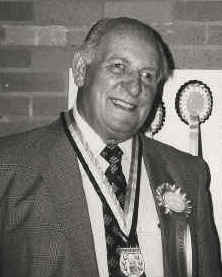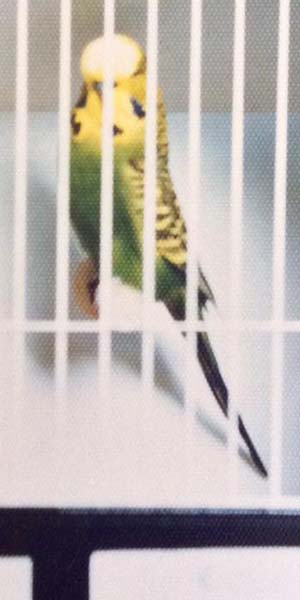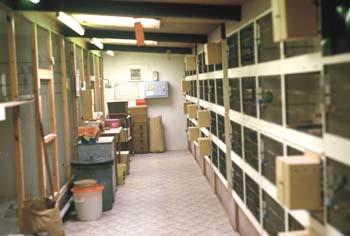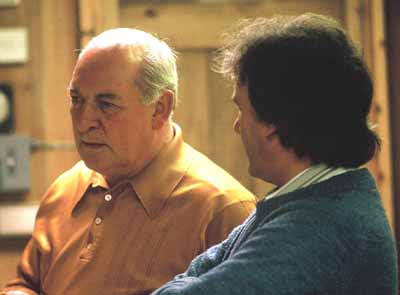
by Alf Ormerod
There has been a lot written about breeding
budgerigars. Many beginners get the impression that all they need to do is
buy the birds, cages and nest-boxes, and books to produce youngsters.
I agree that breeding pet birds is easier than
building up a team for show purposes. The better the quality the more
difficult it becomes to retain it and produce big winners regularly.
To me this difficulty is what makes the hobby: a
challenge to breed one better than ever before. It is quality first, not
quantity, that counts yet one must not lose sight of the fertility potential
of your stock or else you very soon get good looking birds that cannot
produce their like.

How do I start my breeding season? First of all,
during the show season I have been looking for new blood, birds with certain
good points to introduce into a stud that I thought could be improved by
them. You must never be satisfied with your stock unless you cannot find any
better.
In most cases when you get to the top the bird you
want cannot be bought, but sometimes by exchanging a good one for it you
gain your objective. A number of years ago I exchanged three good birds to
get the one I wanted and that was a move I never regretted.
By the middle of December my pairings are complete on
paper. First of all I select my best hens of each color; good hens are
essential for success but they must have the pedigree as well as the looks.
Next I select the cocks. First of all I weigh up and fault or point I wish
to improve in the hen and find the cock that can or should improve thess
failings. Then I check relationship and pedigree.
Having made a note of my best pairs I follow with the
second best, but I never put up any pairs for the sake of breeding
youngsters. The object is to get some improvement and if I do not think a
pair can do that I do not pair them up.
I am one of the early breeders. I do not intend to
argue with the late breeding school, my only comment being I prefer to breed
early. I get the results in time
to have a holiday (vacation), before the show season gets underway. My early
youngsters are through the moult for the mid-year shows.
Pairs are generally put together during the first
week of December but before this all breeding cages are thoroughly cleaned
out and floor and cages washed out with hot water to which plenty of
antiseptic has been added. The birds are introduced according to my prepared
list provided they are in breeding condition. I do not worry if a bird has
no tail, spots are missing or a few feathers are lacking on his or her head.
If they are bright in the eye, active and alert they are ready.
It is generally written that if the hen does not have
a good brown cere she is not ready for breeding. This is a point I have not
agreed with for a number of years. In fact, I have one family of hens whose
ceres turn whitish when they are in peak condition.
I would never mate a cock if his cere was not a good
blue, even if he seems to be in breeding condition, otherwise, generally
only clear aggs are the result even though he has been treading regularly.
The pairs are put in their breeding cage and a record card pinned to each
cage with the color of each bird, ring number etc.

Having put pairs together I like to stay for a while
to noate such reactions as hens going down for treading, the pair feeding
each other etc. Make sure if using cages that are separated by slides that
these are secure. I like the slides to make a good fit as some birds want to
pay more attention to the birds in the next compartment than their own
partner. If a slide is loose and a bird forces its way through, when you
arrive home from work you may have a dead or injured bird on your hands.
If using birds from which I bred together the
previous year, I prefer to give them new mates. I put the birds concerned in
cages far away from each other as possible but even so, in some cases, you
will hear them calling to each other for a few days. They then settle down
to the new partner in most instances, but I have had cases where they would
not do so and I have eventually put the two back together again.
Usually it has been possible to make up another pair
from the other two birds, but where they are unsuitable for each other, I
have had to find new partners from the birds kept in reserve. Some pairs may
fight each other but start feeding each other soon afterwards. These birds
need watching if left together as while some, after a fight or two, settle
and make excellent breeding pairs, others will not give in.
Both want to be boss and even though the eggs are
fertile, they may fight in the box and smash the lot or even kill the
youngsters. You have to split them up or take a chance. Generally I take the
chance but put eggs as laid under another pair and let the pugilists have
some clear eggs to see if they will settle better when sitting the second
time. If that happens, I then try with a newly hatched youngster transferred
from a pair that has four or more. If all goes well they are allowed to keep
their own in the next round.
If hens have not laid two weeks after the nest-boxes
were put up, look for heavy swelling at the vent. The hen may not be passing
her eggs. If so, do not leave them unattended too long or they will die.
Such a hen is usually finished, but occasionally, if given twelve months in
the flight, will lay an odd egg or two the following year then swell up
again. If she is a really outstanding hen and you can get one youngster from
her it might well be worth the trouble.
Other hens may not lay with one cock but will with
another. A cock can be seemingly infertile with one hen but a very good
breeder with another. During the sitting and feeding period watch the hens
for swelling in the legs. If this occurs and the rings are tight, dip the
legs in clear iodine, witch hazel or a similar lotion available from
chemists. If the condition is very bad it may be necessary to cut off the
ring or rings rather than lose the bird.
Do not be afraid of inspecting your nest-boxes. Get
your hens used to you doing so before they have laid. From the time I first
put up the boxI make a regular habit of looking in every day. This lets the
hen know she is not in any danger and then when she starts sitting and you
opan the box, she is not scared, and does not scatter the eggs. All my hens
while sitting and feeding just walk gently out of the box when I wish to
check eggs, or ring chicks etc.
It is not necessary to use heaters in your breeding
room, but I have one for my own comfort. If you do have one in the room be
sure you have a container of water over them to preserve a degree of
humidity. More chicks, I believe, die in the shell through the skins getting
tough and dry following the use of electric heaters without water, than
anything else.
During the hot summer months, when we keep the
containers filled up, damp the floor or occasionally dip the eggs in luke
warm water. Make sure your eggs are kept reasonably clean as some hens are
dirty in the box and if your eggs get covered with excreta the chick will
die.
Mine are normally alright as I renew sawdust should
any hens carry it out. If your eggs are dirty, clean them with warm water,
using a piece of soft cloth or a shaving brush. Then replace them in the
box. When ringing your chicks be careful not to damage the toe-nails. Many
really outstanding birds have this fault and have to be penalized when in a
hot class. It is much easier to ring a bird twice because a ring came off
than miss ringing it or damage it by leaving it too late.
While your young are in the box inspect their claws
and beaks often. Excreta gathering around the nails stops their growth and
can join the toes together. When this happens your youngsters leave the box
with a faulty foot and cannot grip the perches properly. Be careful when
removing dirt that you do not pull out the nails. A damp soft cloth is all
you need to clean them.
Keep the outside of the beaks clean by the same
method, but also clean out the inside. Food clots inside, sets hard, and
stops normal development, resulting in overshot or undershot beaks. Clean
them with a pointed match like you may use for ringing.
During the first few days watch out for youngsters
with wind. A lot of birds die through this but it is easily recognized and
can be cured. If you see a youngster with a swollen throat like a water
blister, that is wind. Just lay it on its back and press the “blister”
gently between the finger and thumb until the bird opens its beak. Relieve
the pressure for a second then repeat the process until the “blister” is
gone. The hen can then feed the chick alright, but sometimes it needs to be
done again the following day.
This generally happens with young hens. They will not
leave the youngsters to come out and feed and, having nothing in their crops
they go through the motions of feeding and the youngsters become filled with
air, as happens when a baby sucks on an empty milk bottle.
Look for feather plucking as time goes on. Some hens
will pluck one color and not another; if so, remove those of that color in a
mixed nest, but before doing so decide which nest you are going to transfer
them to.
When I move a chick I make a habit of rubbing a
little olive oil on my hands and stroke the others in the nest I am
transferring it to. In this way all the youngsters will smell alike. I am
convinced a hen knows her own by smell, but always transfer to a nest of the
same color if possible.
If a hen has four youngsters with others to hatch I
try to put the other eggs under another pair that are hatching, but pick a
nest of another color so you can pick out the transferred birds.
Alternatively, you can transfer a ringed chick to another nest of similar
size.
Save your clear aggs. I find them useful to put in a
nestbox where a hen has hatched all her own eggs. I usually put in a couple.
They help to keep the small chicks from getting crushed.
When your youngsters begin to leave the nest see that
the cock does not attack them. I generally find that this occurs when only
one comes out and the cock thinks it should be in the box. Generally if you
put another youngster with it on the bottom of the cage the cock settles
down and begins to feed them.
Do not be in a hurry to remove your youngsters from
the breeding cage even if they are feeding themselves so long as the parents
are happy with them. I leave some until they are eight weeks old. Do not
move any under six weeks unless forced to, but even then, be sure they are
feeding satisfactorily.
When you transfer them, transfer them to show cages
to start their show training. I find that putting two together is best; they
are company for each other.

How would I form a stud? I say a ”stud” because in
Budgies there is no such thing as a strain comparable to those we have in
Pigeons. Budgies do not behave like other forms of livestock when
inter-breeding over a period of years. I do not know why, and to keep on top
one must always be on the look-out for a new bird or two each year,
preferably from a different part of the country.
I have always told beginners and novices that I have
been careful to see I use only matched pairs. Follow my advice for three
years then you are on your own.
First of all, decide what you can afford to spend. If
capital is limited (and mine certainly was when I started as a lad) get two
matched pairs instead of buying a lot of cheap birds. Buy from a fancier who
has proved over the years that he is breeding good youngsters. Tell him what
you can afford and let him match the birds. He knows his birds and what will
do best for you. Good birds cannot be bought cheaply. Quality both in
pedigree and looks control price as in anything else.
Keep your mated pairs. Select the following year the
best cock and hen from each pair. Pair father x daughter and mother x son.
Again select the best and for the third year pair the best from line one to
the best from line two.
By now you should have a number of winners around you
and will need another bird or two. Having some good birds you can sell or
use them to affect exchanges. You can go back to your same breeder; he will
still have birds to suit your needs.
Alternatively, you can go elsewhere and breed from
your new stock on the same lines as before, always keeping your best
together. But watch out for infertility, poor layers, bad feeders, etc…, and
rectify these points by using birds that are good in these respects.
Interesting Note:
When we visited Alf & Doris in Preston Alf had me sign his guestbook. The
names directly above mine were a couple of breeders from Germany who had
been there to buy birds.. The names were not well known then, but they are
today.... Jo Mannes, and the young chap with him... Reinhardt Molkentin. ~
Bob Wilson
